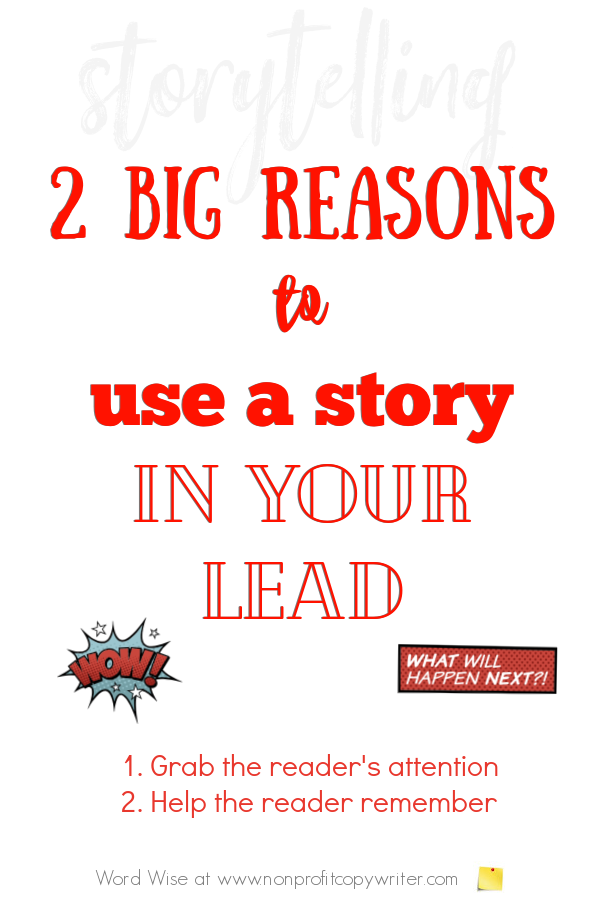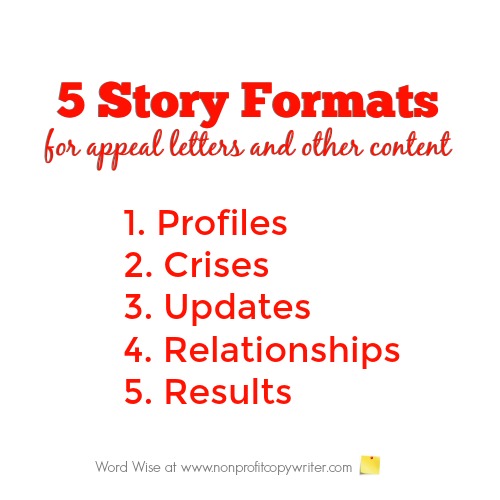Save Time: Get 5 Simple Writing Tips
you can put to use in 10 minutes
Open Your Content with One of These 5 Story Formats
Award-winning writer Kathy Widenhouse has helped hundreds of nonprofits and writers produce successful content , with 750K+ views for her writing tutorials. She is the author of 9 books. See more of Kathy’s content here.
Updated 10.14.25
“Have you read this story?” my husband asked, wiping his eyes with one hand and waving his phone in the other.
I shook my head.
He forwarded the link containing a profile about a courageous ALS victim. “Check it out,” he went on. “But only when you have a few minutes to cry and recover.” He left the room to blow his nose.
I read it right away. Then ran to the bathroom to wash the tears off my face.
You can get the same reaction when you write persuasive stories.
A story captures your attention
There are two key aspects to an effective story, says Paul J. Zak, Ph.D., writing in Science. “First, it must capture and hold our attention. The second thing an effective story does is ‘transport’ us into the characters’ world.”
In other words, a good story shines a spotlight on a tiny slice of life. And since the human brain has a short attention span, storytellers who increase the tension keep a reader’s attention.
Sustain your reader’s interest for any length of time and a funny thing happens in his brain. He’s got increased levels of oxytocin –the neurochemical responsible for empathy, or what Zak calls “the moral molecule.”
It happens when ...
- Your heart rate increase during a movie’s chase scene.
- Or your anger rises when you read about an innocent child who falls to a stray bullet.
- Or a middle aged man gets choked with tears when reading about a courageous ALS victim.
Now, your reader is invested in the characters and what happens to them. So he keeps reading.
A story helps you remember
It makes sense to engage the reader at the top of your content because he gets emotionally involved.
But he also has a greater chance of remembering what you write about.
“A story is up to 22 times more memorable than facts alone. So says Dr. Jennifer Aaker of the Stanford Graduate School of Business.
Aaker conducted a study with students who had a give a one-minute pitch. Nine of 10 presentations were dominated by facts and figures. The tenth presentation told a human story.
In the end, only 5% of the audience could recall a statistic from one of the presentations. But two-thirds – 63% - remembered the stories.
"I've got the story, but I don't know how to write it"
You’ve got a moving account from a beneficiary about the impact of your nonprofit. But how do you tell the tale?
There’s no one “magic bullet” formula. I’ve been choked up by profiles, moved by the reports of devastation during a natural disaster, and thrilled when I’ve read the results of victims’ courage.
If you have a hard time knowing how to present your nonprofit’s stories, start with these formats.
1. Profiles
Personality sketches humanize a problem and demonstrate need for your cause. Thousands now empathize with victims of Parkinson’s disease, for example, because of Michael J. Fox. His boyish good looks and transparency put a face on the issue. You needn’t interview a celebrity to make an impact with a profile – in fact, Joe Average resonates with readers because he’s Everyman.
2. Crises
Hurricane Katrina blew through the Gulf States in August 2005, leaving a wake of devastation and destruction. A year later, charities reported that generous donors had contributed a total of $4 billion in gifts to help victims recover.
But it wasn’t the disaster’s $75 billion price tag that prompted people to give. Instead, stories of children who couldn’t find their parents and narratives of senior citizens who had lost their homes while rescuing others drove people to open their hearts and their wallets.
3. Updates
Lila is thirteen and probably won’t live past sixteen. A year ago, she asked an organization to help her raise funds to grant the wishes of 100 other terminally-ill children. Regular updates about Lila’s Wish and how it is being fulfilled make for a host of moving narratives that stir readers to get on board.
4. Relationships
The world watched Nancy Reagan’s life unfold in the 1990’s as her husband battled Alzheimer’s disease. Families of Alzheimer’s patients, in particular, identified with Mrs. Reagan, inspired by her courage as she faced a private struggle in a very public way. Tell a story from the point of view of a loved one. Readers relate to relationships because they have their own.
5. Results
Who doesn’t cheer for the special-needs runner that trips on the track, gets back in the race and wins a medal … the teen birth mother who withstands her family’s rejection to carry her baby to term and place him in a loving adoptive family … the kid from the broken home who, with a committed mentor, turns a drug conviction around and graduates from college? Show the outcomes of your ministry to individual people. You’ll give your readers new heroes. They’ll eat up stories about victory in the lives of those you serve.
Use a story to open your content
All kinds of story formats grab our hearts. Pick one and spin your tale. If the first format doesn’t work, try a different approach. You've got 5 good ones here to start with.
And keep trying until it works.
Yes, it takes courage to show readers the fear, anger, frustration, love, hope, and regret that people experience by opening your content with a story.
But a powerful story does more than just get your reader to read what you’ve written. A powerful story also helps him to remember it.
More Story Writing Tips
How To Write and Use 3-Sentence Stories ...
Why You MUST Master Persuasive Storytelling ...
3 Story Writing Mistakes to Avoid (If You Want to Make a Point) ...
A Simple 3-Part Story Writing Format for Powerful Content Stories ...
3 Tips for Writing Short Stories that Hook Your Readers ...
Why Telling Stories Sticks, Especially for Readers: It’s Science!
12 Places to Look for Story Writing Ideas ...
Using anecdotes: how to capture readers with a slice of life ...
Using anecdotes in your promotions: how to get a collection system in place
7 Basic Story Plots for Powerful Content Writing ...
The Simple 5-Step Story Structure for Writing Quick Content Stories ...
How to write a story to make a point ...
Tips for getting stories from clients ...
20 interview questions that guarantee a compelling story ...
More tips on our Writing Stories Pinterest board ...
Return from Open Your Content with One of THese 5 Story Formats
to Nonprofit Copywriter home
As an Amazon Associate I earn from qualifying purchases.
Share This Page

Named to 2022 Writer's Digest list
BEST GENRE/NICHE WRITING WEBSITE


Stop Wasting Time!
Grab your exclusive FREE guide, "5 Simple Writing Tips You Can Put to Use in 10 Minutes or Less"













